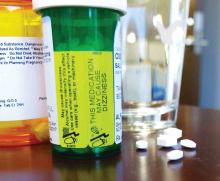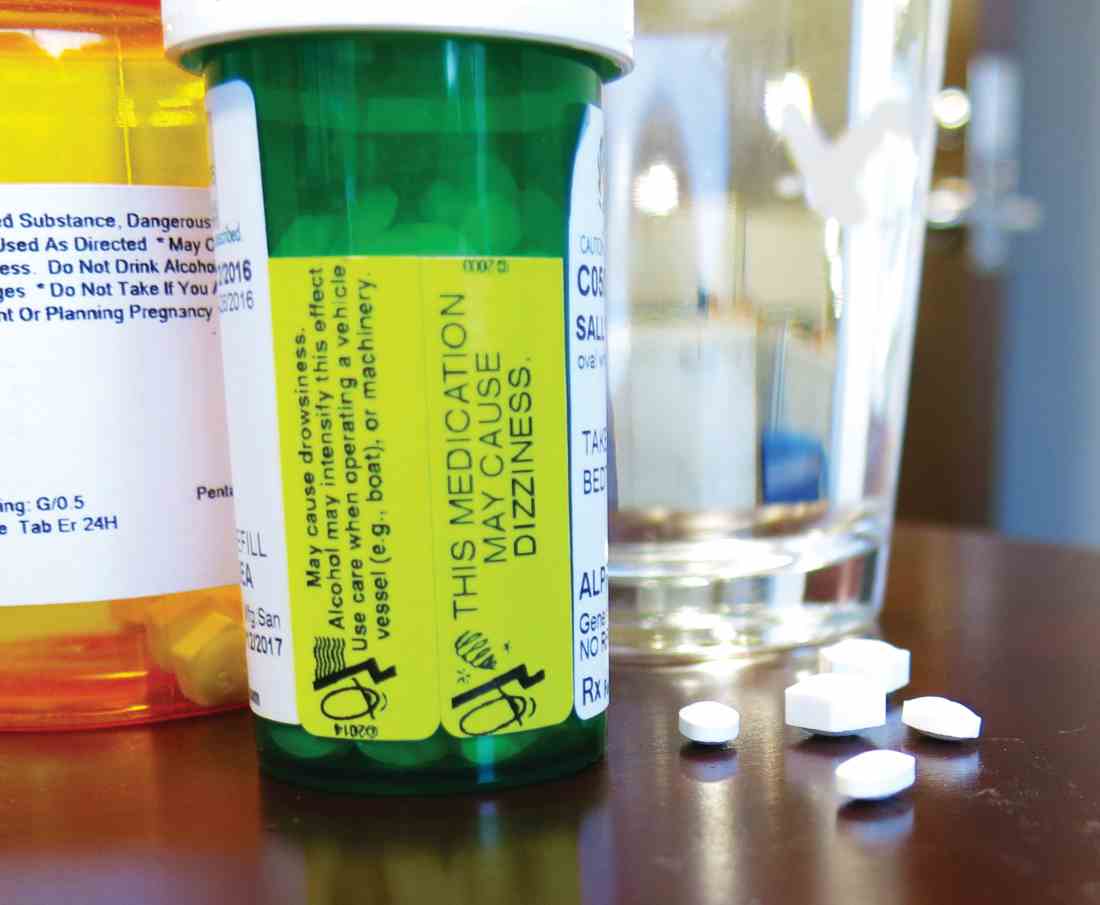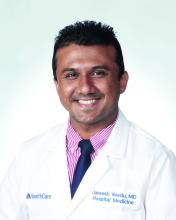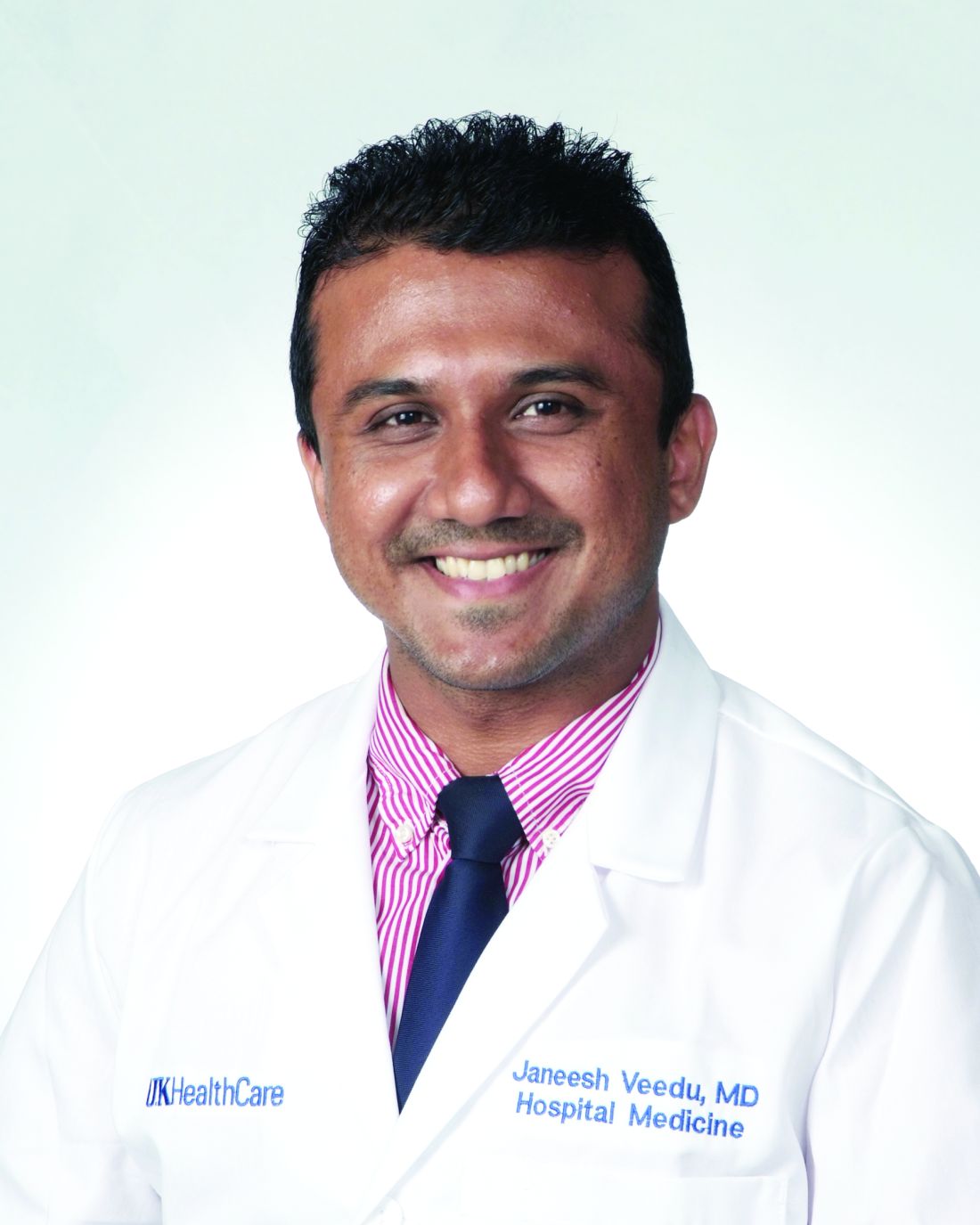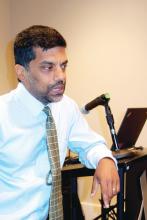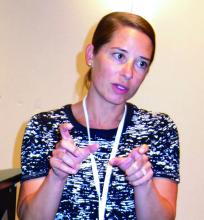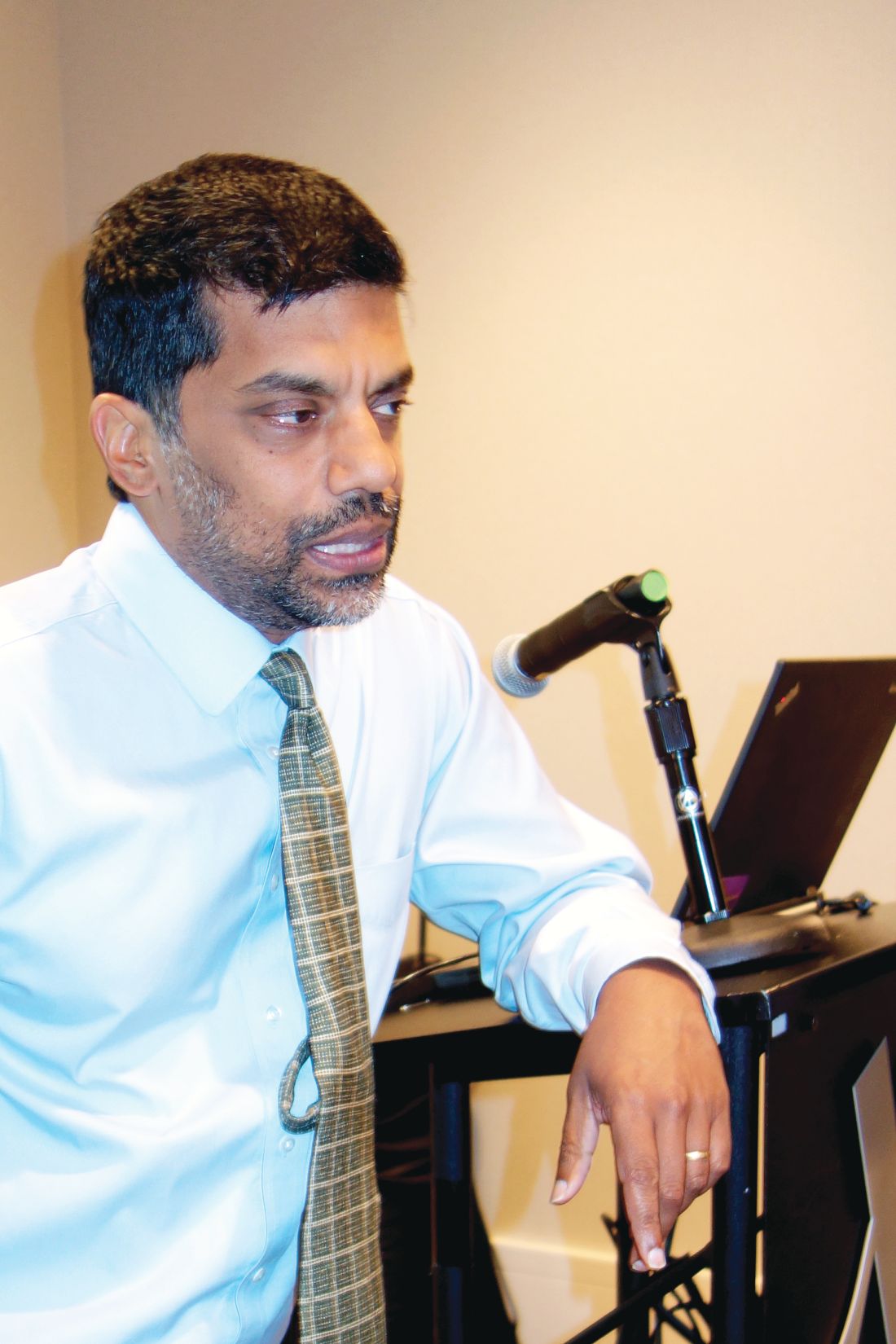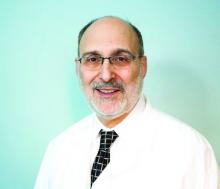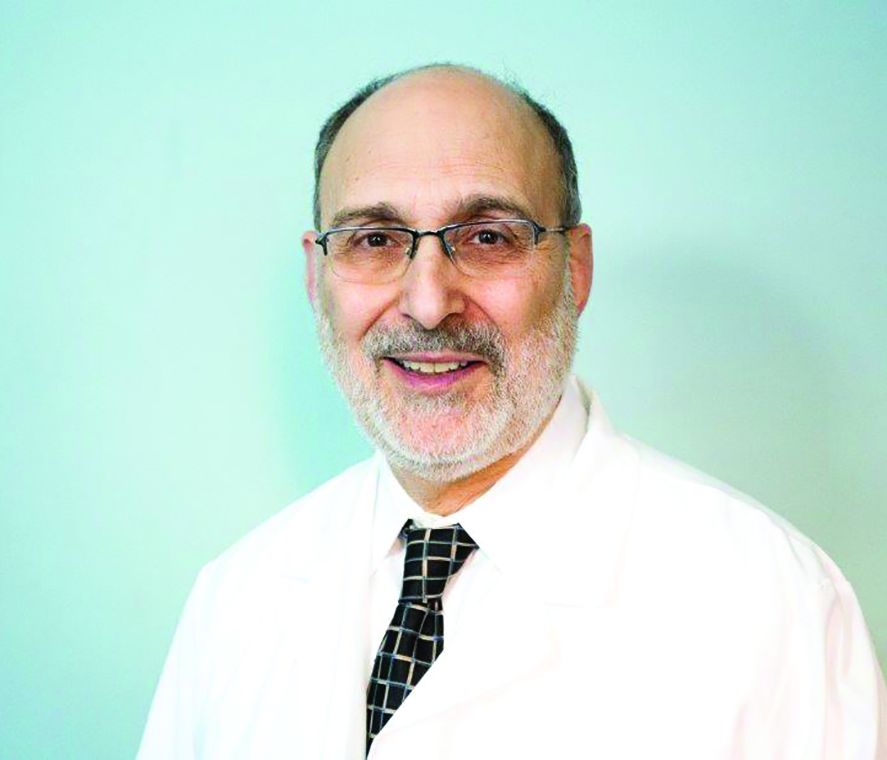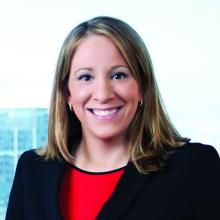User login
Consider dosing as well as drug choice for anxiety disorders
ESTES PARK, COLO. – The first-line medications for anxiety disorders are the same ones used for depression – the SSRIs and serotonin and norepinephrine reuptake inhibitors (SNRIs) – but the dosing strategies are quite different, Elizabeth L. Lowdermilk, MD, said at a conference on internal medicine sponsored by the University of Colorado.
“We know that folks with anxiety disorders tend to need the higher doses. They just need to get there a little more slowly,” according to Dr. Lowdermilk, a psychiatrist at the university and medical director of outpatient psychiatry at Denver Health.
“The trick is not what drug you use, it’s what dose you started at. For example, when I start sertraline for depression I start it at 50 mg per day. When I start it for anxiety I start it at 25. I just give it a week or 2 at 25 and then I double it to 50. And then I keep going, titrating over 2-3 months to a high or maximum dose,” she explained.
The rapidity of response to the SSRIs and SNRIs is quite different, too. When patients are started on one of these agents as treatment for depression, they can expect that it will take at least 4-6 weeks and maybe as long as 12 weeks before they experience the full therapeutic effect. Not so when the same drugs are used to treat anxiety disorders.
“The anxiolytic effect seems to be more robust sooner. Really, people start noticing something within the first couple days to a week. And they will keep getting better, which people love,” Dr. Lowdermilk said.
One of the early positive effects of SSRI/SNRI therapy that patients can be advised to be on the lookout for is “the Teflon mind,” she said.
“It’s not that the worried thoughts won’t arise, but they’re going to slide out faster and patients are going to be able to shift their focus back to where they want it to be and move forward,” the psychiatrist explained.
Other positive treatment effects include reductions in irritability, anger, perseverative thoughts, restlessness, and physical tension, along with improved sleep.
How to monitor patient response
The most practical anxiety rating scale for busy primary care physicians with tight office visit scheduling is the seven-item Generalized Anxiety Disorder Assessment, or GAD 7. It can be used repeatedly to follow a patient’s treatment response.
“While technically it is picking up the symptoms of GAD, because there are so many overlapping symptoms in all of the anxiety disorders this is going to give you a sense of whether someone is getting better. It won’t pick up their nightmares if they have PTSD, and it won’t necessarily pick up their checking behaviors if they have obsessive-compulsive disorder – you can ask them quickly about that,” she said.
Augmenting an SSRI/SNRI
Be advised: While some patients with an anxiety disorder will experience complete resolution of symptoms on the maximum approved dose of an SSRI/SNRI, such as 200 mg/day of sertraline (Zoloft), lots of patients will have only a partial response. The next move is not to add a second antidepressant, it’s to augment the high-dose antidepressant the patient is already on with something else. Dr. Lowdermilk highlighted the best and worst strategies:
- Hydroxyzine: This drug, approved by the Food and Drug Administration for treatment of panic attacks at 25-50 mg up to four times per day, has sedating side effects that help with sleep issues.
“We use a lot of this,” Dr. Lowdermilk said.
Hydroxyzine (Vistaril) can be dosed on a fixed schedule or as needed. She strongly favors scheduled dosing. “It’s better to use drugs to reduce anxiety tone, then teach skills to cope with anxiety. As needed treatment subtly teaches patients to take a pill if they have breakthrough symptoms.”
- Buspirone: It takes high doses of this medication to get a robust anxiolytic response. Dr. Lowdermilk recommends starting at 5 mg three times daily and increasing the total daily dose by 15 mg every 2 weeks up to a maximum of 60 mg.
“Buspirone isn’t the strongest medication out there, but it can help. I personally don’t stop until I’m at least at 30 mg per day,” she said.
The drug is especially handy as monotherapy in patients with mild to moderate anxiety who can’t tolerate serotonergic medications well. Also, at higher doses buspirone (Buspar) may reduce the sexual side effects of a concomitant serotonergic agent.
- Gabapentin: Dr. Lowdermilk often turns to this drug off label as an SSRI/SNRI augmentation strategy, starting at 100-300 mg three times daily and increasing over the same time frame as for neuropathic pain up to a maximum total daily dose of 3,600 mg. Like hydroxyzine, it helps with sleep.
- Atypical antipsychotics: Reserve these for patients with an inadequate response to maximum-dose SSRI/SNRI. There is some evidence of efficacy for low-dose risperidone (Risperdal) at 1-2 mg/day, quetiapine(Seroquel) at 50-100 mg, and aripiprazole (Abilify) at 2-5 mg. Because of the risks of metabolic side effects and tardive dyskinesia, it’s best to evaluate the drug’s effectiveness after 2-4 weeks and consider stopping if there is no clinical improvement.
- Benzodiazepines: Yes, they are approved for treatment of anxiety disorders. Nevertheless, Dr. Lowdermilk advises against their as routine practice.
“I want to acknowledge that they really do work for anxiety and there are times you might want to consider them. But we are almost never initiating benzodiazepines anymore. We are learning that they cause more problems than not. What I’ve found over the years is short bursts of use are not short. Patients tend to come back and want more,” according to the psychiatrist.
She is not convinced about the claimed link to dementia, but she does believe long-term use of benzodiazepines is associated with memory and balance problems as well as slowed reaction time. If they are going to be used to treat anxiety disorders, it’s best to turn to a longer-acting agent such as clonazepam (Klonopin) or extended-release alprazolam (Xanax XR), which keep the anxiety tone down without producing the euphoria of short-acting benzodiazepines.
- Behavioral therapies: “I really do think that the combination of medication and behavioral therapy is the best approach,” Dr. Lowdermilk said.
Consider referring patients with a problematic anxiety disorder to a behavioral therapist skilled in cognitive behavioral therapy, exposure therapy, response prevention therapy, or eye movement desensitization and reprocessing.
She reported having no financial conflicts regarding her presentation.
ESTES PARK, COLO. – The first-line medications for anxiety disorders are the same ones used for depression – the SSRIs and serotonin and norepinephrine reuptake inhibitors (SNRIs) – but the dosing strategies are quite different, Elizabeth L. Lowdermilk, MD, said at a conference on internal medicine sponsored by the University of Colorado.
“We know that folks with anxiety disorders tend to need the higher doses. They just need to get there a little more slowly,” according to Dr. Lowdermilk, a psychiatrist at the university and medical director of outpatient psychiatry at Denver Health.
“The trick is not what drug you use, it’s what dose you started at. For example, when I start sertraline for depression I start it at 50 mg per day. When I start it for anxiety I start it at 25. I just give it a week or 2 at 25 and then I double it to 50. And then I keep going, titrating over 2-3 months to a high or maximum dose,” she explained.
The rapidity of response to the SSRIs and SNRIs is quite different, too. When patients are started on one of these agents as treatment for depression, they can expect that it will take at least 4-6 weeks and maybe as long as 12 weeks before they experience the full therapeutic effect. Not so when the same drugs are used to treat anxiety disorders.
“The anxiolytic effect seems to be more robust sooner. Really, people start noticing something within the first couple days to a week. And they will keep getting better, which people love,” Dr. Lowdermilk said.
One of the early positive effects of SSRI/SNRI therapy that patients can be advised to be on the lookout for is “the Teflon mind,” she said.
“It’s not that the worried thoughts won’t arise, but they’re going to slide out faster and patients are going to be able to shift their focus back to where they want it to be and move forward,” the psychiatrist explained.
Other positive treatment effects include reductions in irritability, anger, perseverative thoughts, restlessness, and physical tension, along with improved sleep.
How to monitor patient response
The most practical anxiety rating scale for busy primary care physicians with tight office visit scheduling is the seven-item Generalized Anxiety Disorder Assessment, or GAD 7. It can be used repeatedly to follow a patient’s treatment response.
“While technically it is picking up the symptoms of GAD, because there are so many overlapping symptoms in all of the anxiety disorders this is going to give you a sense of whether someone is getting better. It won’t pick up their nightmares if they have PTSD, and it won’t necessarily pick up their checking behaviors if they have obsessive-compulsive disorder – you can ask them quickly about that,” she said.
Augmenting an SSRI/SNRI
Be advised: While some patients with an anxiety disorder will experience complete resolution of symptoms on the maximum approved dose of an SSRI/SNRI, such as 200 mg/day of sertraline (Zoloft), lots of patients will have only a partial response. The next move is not to add a second antidepressant, it’s to augment the high-dose antidepressant the patient is already on with something else. Dr. Lowdermilk highlighted the best and worst strategies:
- Hydroxyzine: This drug, approved by the Food and Drug Administration for treatment of panic attacks at 25-50 mg up to four times per day, has sedating side effects that help with sleep issues.
“We use a lot of this,” Dr. Lowdermilk said.
Hydroxyzine (Vistaril) can be dosed on a fixed schedule or as needed. She strongly favors scheduled dosing. “It’s better to use drugs to reduce anxiety tone, then teach skills to cope with anxiety. As needed treatment subtly teaches patients to take a pill if they have breakthrough symptoms.”
- Buspirone: It takes high doses of this medication to get a robust anxiolytic response. Dr. Lowdermilk recommends starting at 5 mg three times daily and increasing the total daily dose by 15 mg every 2 weeks up to a maximum of 60 mg.
“Buspirone isn’t the strongest medication out there, but it can help. I personally don’t stop until I’m at least at 30 mg per day,” she said.
The drug is especially handy as monotherapy in patients with mild to moderate anxiety who can’t tolerate serotonergic medications well. Also, at higher doses buspirone (Buspar) may reduce the sexual side effects of a concomitant serotonergic agent.
- Gabapentin: Dr. Lowdermilk often turns to this drug off label as an SSRI/SNRI augmentation strategy, starting at 100-300 mg three times daily and increasing over the same time frame as for neuropathic pain up to a maximum total daily dose of 3,600 mg. Like hydroxyzine, it helps with sleep.
- Atypical antipsychotics: Reserve these for patients with an inadequate response to maximum-dose SSRI/SNRI. There is some evidence of efficacy for low-dose risperidone (Risperdal) at 1-2 mg/day, quetiapine(Seroquel) at 50-100 mg, and aripiprazole (Abilify) at 2-5 mg. Because of the risks of metabolic side effects and tardive dyskinesia, it’s best to evaluate the drug’s effectiveness after 2-4 weeks and consider stopping if there is no clinical improvement.
- Benzodiazepines: Yes, they are approved for treatment of anxiety disorders. Nevertheless, Dr. Lowdermilk advises against their as routine practice.
“I want to acknowledge that they really do work for anxiety and there are times you might want to consider them. But we are almost never initiating benzodiazepines anymore. We are learning that they cause more problems than not. What I’ve found over the years is short bursts of use are not short. Patients tend to come back and want more,” according to the psychiatrist.
She is not convinced about the claimed link to dementia, but she does believe long-term use of benzodiazepines is associated with memory and balance problems as well as slowed reaction time. If they are going to be used to treat anxiety disorders, it’s best to turn to a longer-acting agent such as clonazepam (Klonopin) or extended-release alprazolam (Xanax XR), which keep the anxiety tone down without producing the euphoria of short-acting benzodiazepines.
- Behavioral therapies: “I really do think that the combination of medication and behavioral therapy is the best approach,” Dr. Lowdermilk said.
Consider referring patients with a problematic anxiety disorder to a behavioral therapist skilled in cognitive behavioral therapy, exposure therapy, response prevention therapy, or eye movement desensitization and reprocessing.
She reported having no financial conflicts regarding her presentation.
ESTES PARK, COLO. – The first-line medications for anxiety disorders are the same ones used for depression – the SSRIs and serotonin and norepinephrine reuptake inhibitors (SNRIs) – but the dosing strategies are quite different, Elizabeth L. Lowdermilk, MD, said at a conference on internal medicine sponsored by the University of Colorado.
“We know that folks with anxiety disorders tend to need the higher doses. They just need to get there a little more slowly,” according to Dr. Lowdermilk, a psychiatrist at the university and medical director of outpatient psychiatry at Denver Health.
“The trick is not what drug you use, it’s what dose you started at. For example, when I start sertraline for depression I start it at 50 mg per day. When I start it for anxiety I start it at 25. I just give it a week or 2 at 25 and then I double it to 50. And then I keep going, titrating over 2-3 months to a high or maximum dose,” she explained.
The rapidity of response to the SSRIs and SNRIs is quite different, too. When patients are started on one of these agents as treatment for depression, they can expect that it will take at least 4-6 weeks and maybe as long as 12 weeks before they experience the full therapeutic effect. Not so when the same drugs are used to treat anxiety disorders.
“The anxiolytic effect seems to be more robust sooner. Really, people start noticing something within the first couple days to a week. And they will keep getting better, which people love,” Dr. Lowdermilk said.
One of the early positive effects of SSRI/SNRI therapy that patients can be advised to be on the lookout for is “the Teflon mind,” she said.
“It’s not that the worried thoughts won’t arise, but they’re going to slide out faster and patients are going to be able to shift their focus back to where they want it to be and move forward,” the psychiatrist explained.
Other positive treatment effects include reductions in irritability, anger, perseverative thoughts, restlessness, and physical tension, along with improved sleep.
How to monitor patient response
The most practical anxiety rating scale for busy primary care physicians with tight office visit scheduling is the seven-item Generalized Anxiety Disorder Assessment, or GAD 7. It can be used repeatedly to follow a patient’s treatment response.
“While technically it is picking up the symptoms of GAD, because there are so many overlapping symptoms in all of the anxiety disorders this is going to give you a sense of whether someone is getting better. It won’t pick up their nightmares if they have PTSD, and it won’t necessarily pick up their checking behaviors if they have obsessive-compulsive disorder – you can ask them quickly about that,” she said.
Augmenting an SSRI/SNRI
Be advised: While some patients with an anxiety disorder will experience complete resolution of symptoms on the maximum approved dose of an SSRI/SNRI, such as 200 mg/day of sertraline (Zoloft), lots of patients will have only a partial response. The next move is not to add a second antidepressant, it’s to augment the high-dose antidepressant the patient is already on with something else. Dr. Lowdermilk highlighted the best and worst strategies:
- Hydroxyzine: This drug, approved by the Food and Drug Administration for treatment of panic attacks at 25-50 mg up to four times per day, has sedating side effects that help with sleep issues.
“We use a lot of this,” Dr. Lowdermilk said.
Hydroxyzine (Vistaril) can be dosed on a fixed schedule or as needed. She strongly favors scheduled dosing. “It’s better to use drugs to reduce anxiety tone, then teach skills to cope with anxiety. As needed treatment subtly teaches patients to take a pill if they have breakthrough symptoms.”
- Buspirone: It takes high doses of this medication to get a robust anxiolytic response. Dr. Lowdermilk recommends starting at 5 mg three times daily and increasing the total daily dose by 15 mg every 2 weeks up to a maximum of 60 mg.
“Buspirone isn’t the strongest medication out there, but it can help. I personally don’t stop until I’m at least at 30 mg per day,” she said.
The drug is especially handy as monotherapy in patients with mild to moderate anxiety who can’t tolerate serotonergic medications well. Also, at higher doses buspirone (Buspar) may reduce the sexual side effects of a concomitant serotonergic agent.
- Gabapentin: Dr. Lowdermilk often turns to this drug off label as an SSRI/SNRI augmentation strategy, starting at 100-300 mg three times daily and increasing over the same time frame as for neuropathic pain up to a maximum total daily dose of 3,600 mg. Like hydroxyzine, it helps with sleep.
- Atypical antipsychotics: Reserve these for patients with an inadequate response to maximum-dose SSRI/SNRI. There is some evidence of efficacy for low-dose risperidone (Risperdal) at 1-2 mg/day, quetiapine(Seroquel) at 50-100 mg, and aripiprazole (Abilify) at 2-5 mg. Because of the risks of metabolic side effects and tardive dyskinesia, it’s best to evaluate the drug’s effectiveness after 2-4 weeks and consider stopping if there is no clinical improvement.
- Benzodiazepines: Yes, they are approved for treatment of anxiety disorders. Nevertheless, Dr. Lowdermilk advises against their as routine practice.
“I want to acknowledge that they really do work for anxiety and there are times you might want to consider them. But we are almost never initiating benzodiazepines anymore. We are learning that they cause more problems than not. What I’ve found over the years is short bursts of use are not short. Patients tend to come back and want more,” according to the psychiatrist.
She is not convinced about the claimed link to dementia, but she does believe long-term use of benzodiazepines is associated with memory and balance problems as well as slowed reaction time. If they are going to be used to treat anxiety disorders, it’s best to turn to a longer-acting agent such as clonazepam (Klonopin) or extended-release alprazolam (Xanax XR), which keep the anxiety tone down without producing the euphoria of short-acting benzodiazepines.
- Behavioral therapies: “I really do think that the combination of medication and behavioral therapy is the best approach,” Dr. Lowdermilk said.
Consider referring patients with a problematic anxiety disorder to a behavioral therapist skilled in cognitive behavioral therapy, exposure therapy, response prevention therapy, or eye movement desensitization and reprocessing.
She reported having no financial conflicts regarding her presentation.
REPORTING FROM COLORADO IM
Maternal immunization: What does the future hold?
Immunization resources
Current recommended adult (anyone over 18 years old) immunization schedule
ACOG Immunization Champions (ACOG members who have demonstrated exceptional progress in increasing immunization rates among adults and pregnant women in their communities through leadership, innovation, collaboration, and educational activities aimed at following ACOG and CDC guidance.)
Summary of Maternal Immunization Recommendations is a provider resource from ACOG and the Centers for Disease Control and Prevention.
Maternal Immunization Toolkit contains materials, including the Vaccines During Pregnancy Poster, to support ObGyns on recommending the influenza vaccine and the Tdap vaccine to all pregnant patients.
Immunization resources
Current recommended adult (anyone over 18 years old) immunization schedule
ACOG Immunization Champions (ACOG members who have demonstrated exceptional progress in increasing immunization rates among adults and pregnant women in their communities through leadership, innovation, collaboration, and educational activities aimed at following ACOG and CDC guidance.)
Summary of Maternal Immunization Recommendations is a provider resource from ACOG and the Centers for Disease Control and Prevention.
Maternal Immunization Toolkit contains materials, including the Vaccines During Pregnancy Poster, to support ObGyns on recommending the influenza vaccine and the Tdap vaccine to all pregnant patients.
Immunization resources
Current recommended adult (anyone over 18 years old) immunization schedule
ACOG Immunization Champions (ACOG members who have demonstrated exceptional progress in increasing immunization rates among adults and pregnant women in their communities through leadership, innovation, collaboration, and educational activities aimed at following ACOG and CDC guidance.)
Summary of Maternal Immunization Recommendations is a provider resource from ACOG and the Centers for Disease Control and Prevention.
Maternal Immunization Toolkit contains materials, including the Vaccines During Pregnancy Poster, to support ObGyns on recommending the influenza vaccine and the Tdap vaccine to all pregnant patients.
Trainees Can Learn About Health Policy, Advocacy
Coding. Practice expenses. Supervised Exercise Therapy. The vascular lab. Medicare reimbursement (including MACRA, MIPS, APMs and QPP). All these topics and more are part of a vascular surgeon's life and livelihood. Vascular surgery trainees interested in health policy and advocacy issues related to vascular surgery are encouraged to apply for the SVS Vascular Surgery Trainee Advocacy Travel Scholarship. Submissions are due by Oct. 31. The winner receives $1,500 to defray travel costs to Washington, D.C., to participate in Capitol Hill visits and learn more about SVS' health policy and advocacy activities.
Coding. Practice expenses. Supervised Exercise Therapy. The vascular lab. Medicare reimbursement (including MACRA, MIPS, APMs and QPP). All these topics and more are part of a vascular surgeon's life and livelihood. Vascular surgery trainees interested in health policy and advocacy issues related to vascular surgery are encouraged to apply for the SVS Vascular Surgery Trainee Advocacy Travel Scholarship. Submissions are due by Oct. 31. The winner receives $1,500 to defray travel costs to Washington, D.C., to participate in Capitol Hill visits and learn more about SVS' health policy and advocacy activities.
Coding. Practice expenses. Supervised Exercise Therapy. The vascular lab. Medicare reimbursement (including MACRA, MIPS, APMs and QPP). All these topics and more are part of a vascular surgeon's life and livelihood. Vascular surgery trainees interested in health policy and advocacy issues related to vascular surgery are encouraged to apply for the SVS Vascular Surgery Trainee Advocacy Travel Scholarship. Submissions are due by Oct. 31. The winner receives $1,500 to defray travel costs to Washington, D.C., to participate in Capitol Hill visits and learn more about SVS' health policy and advocacy activities.
Vascular Nurses Get SVS Member Application Discount
It’s Vascular Nurses Week this week, and as part of the celebration, the SVS is inviting Society for Vascular Nursing members to join the SVS as affiliate members. Applicants will receive a 50 percent discount through Dec. 1. Email CVs and the completed membership form to membership@vascularsociety.org.
It’s Vascular Nurses Week this week, and as part of the celebration, the SVS is inviting Society for Vascular Nursing members to join the SVS as affiliate members. Applicants will receive a 50 percent discount through Dec. 1. Email CVs and the completed membership form to membership@vascularsociety.org.
It’s Vascular Nurses Week this week, and as part of the celebration, the SVS is inviting Society for Vascular Nursing members to join the SVS as affiliate members. Applicants will receive a 50 percent discount through Dec. 1. Email CVs and the completed membership form to membership@vascularsociety.org.
Predicting stent failure in the treatment of May-Thurner syndrome
BOSTON – The use of an intravascular ultrasound (IVUS)–based scoring system could predict stent failure at 2 years in the treatment of May-Thurner syndrome, according to Steven D. Abramowitz, MD, of the MedStar Washington Hospital Center, Washington, and his colleagues.
Dr. Abramowitz presented their research in the Vascular and Endovascular Society (VESS) sessions held at the Vascular Annual Meeting.
“IVUS has become an important adjuvant diagnostic tool in the treatment of deep venous disease, and as such may provide a useful assessment and predictive tool for treatment success in stenting of May-Thurner syndrome,” said Dr. Abramowitz.
In their study, 118 consecutive patients with May-Thurner syndrome underwent IVUS-guided stent placement from April 2009 through May 2015 at two collaborating institutions. Patients had a mean age of 46 years and included 86 (73%) women. At the time of treatment, 45, 30, 25, and 18 patients had Clinical Etiology Anatomy Pathophysiology disease 3, 4, 5, and 6, respectively.
Dr. Abramowitz described how he and his colleagues derived an IVUS-driven scoring system to assess the following categories of May-Thurner syndrome (nonocclusive or occlusive), disease chronicity (nonthrombotic, acute, or chronic), venous disease length (less than 180 mm or greater than 181 mm), venous inflow compliance (presence or absence of respiratory variation), iliocaval confluence disease involvement (present or absent), iliocaval con-fluence stenting obligation (stented or spared), and presence of perivenous collaterals before and after stenting (none or resolved).
Six of the categories were scored with 0 or 1 and one category was scored with 0, 1, or 2. Scores were tabulated for each patient at the time of initial intervention.
All 118 (100%) patients received anticoagulation and 78 (66%) were on an antiplatelet agent. Thirty-eight (32%) developed moderate in-stent stenosis, required thrombolysis, or underwent additional stenting procedures and were considered treatment failures during the observed period.
Eighty patients (68%) required no additional intervention and were considered treatment successes. The mean IVUS score for all patients was 5.22. The mean IVUS score in the treatment failure cohort was 5.64 compared with a score of 4.67 in the treatment success group, a significant difference. Patients with a score above 4 on this 7-point scale had an increased relative risk (1.6) of stent failure at 2 years.
“An IVUS-driven scoring system score of 4 or greater during initial intervention for May-Thurner syndrome predicts failure at 2 years. Additional treatment modalities should be considered at implantation to prevent failure,” said Dr. Abramowitz.
In an interview, Dr. Abramowitz added: “There is an emerging body of research regarding outcomes of deep venous intervention. However, we are still looking to generate clinically relevant data that will help guide interventionists to achieve durable technical success and long-term positive clinical outcomes for our patients.
“At this time, there is very little data to help correlate what physicians see on venography and IVUS during the treatment of May-Thurner Lesions. This data is hopefully the first step in allowing us to guide intra-operative decision making. IVUS is an excellent tool that has been proven by other studies to aid in the diagnosis and management of venous disease. With this data we also hope that it becomes a drive of patient management as well. Ideally, this data will transition into also guiding anticoagulation management, postoperative surveillance strategies and outcomes stratification for patients,” Dr. Abramowitz concluded.
BOSTON – The use of an intravascular ultrasound (IVUS)–based scoring system could predict stent failure at 2 years in the treatment of May-Thurner syndrome, according to Steven D. Abramowitz, MD, of the MedStar Washington Hospital Center, Washington, and his colleagues.
Dr. Abramowitz presented their research in the Vascular and Endovascular Society (VESS) sessions held at the Vascular Annual Meeting.
“IVUS has become an important adjuvant diagnostic tool in the treatment of deep venous disease, and as such may provide a useful assessment and predictive tool for treatment success in stenting of May-Thurner syndrome,” said Dr. Abramowitz.
In their study, 118 consecutive patients with May-Thurner syndrome underwent IVUS-guided stent placement from April 2009 through May 2015 at two collaborating institutions. Patients had a mean age of 46 years and included 86 (73%) women. At the time of treatment, 45, 30, 25, and 18 patients had Clinical Etiology Anatomy Pathophysiology disease 3, 4, 5, and 6, respectively.
Dr. Abramowitz described how he and his colleagues derived an IVUS-driven scoring system to assess the following categories of May-Thurner syndrome (nonocclusive or occlusive), disease chronicity (nonthrombotic, acute, or chronic), venous disease length (less than 180 mm or greater than 181 mm), venous inflow compliance (presence or absence of respiratory variation), iliocaval confluence disease involvement (present or absent), iliocaval con-fluence stenting obligation (stented or spared), and presence of perivenous collaterals before and after stenting (none or resolved).
Six of the categories were scored with 0 or 1 and one category was scored with 0, 1, or 2. Scores were tabulated for each patient at the time of initial intervention.
All 118 (100%) patients received anticoagulation and 78 (66%) were on an antiplatelet agent. Thirty-eight (32%) developed moderate in-stent stenosis, required thrombolysis, or underwent additional stenting procedures and were considered treatment failures during the observed period.
Eighty patients (68%) required no additional intervention and were considered treatment successes. The mean IVUS score for all patients was 5.22. The mean IVUS score in the treatment failure cohort was 5.64 compared with a score of 4.67 in the treatment success group, a significant difference. Patients with a score above 4 on this 7-point scale had an increased relative risk (1.6) of stent failure at 2 years.
“An IVUS-driven scoring system score of 4 or greater during initial intervention for May-Thurner syndrome predicts failure at 2 years. Additional treatment modalities should be considered at implantation to prevent failure,” said Dr. Abramowitz.
In an interview, Dr. Abramowitz added: “There is an emerging body of research regarding outcomes of deep venous intervention. However, we are still looking to generate clinically relevant data that will help guide interventionists to achieve durable technical success and long-term positive clinical outcomes for our patients.
“At this time, there is very little data to help correlate what physicians see on venography and IVUS during the treatment of May-Thurner Lesions. This data is hopefully the first step in allowing us to guide intra-operative decision making. IVUS is an excellent tool that has been proven by other studies to aid in the diagnosis and management of venous disease. With this data we also hope that it becomes a drive of patient management as well. Ideally, this data will transition into also guiding anticoagulation management, postoperative surveillance strategies and outcomes stratification for patients,” Dr. Abramowitz concluded.
BOSTON – The use of an intravascular ultrasound (IVUS)–based scoring system could predict stent failure at 2 years in the treatment of May-Thurner syndrome, according to Steven D. Abramowitz, MD, of the MedStar Washington Hospital Center, Washington, and his colleagues.
Dr. Abramowitz presented their research in the Vascular and Endovascular Society (VESS) sessions held at the Vascular Annual Meeting.
“IVUS has become an important adjuvant diagnostic tool in the treatment of deep venous disease, and as such may provide a useful assessment and predictive tool for treatment success in stenting of May-Thurner syndrome,” said Dr. Abramowitz.
In their study, 118 consecutive patients with May-Thurner syndrome underwent IVUS-guided stent placement from April 2009 through May 2015 at two collaborating institutions. Patients had a mean age of 46 years and included 86 (73%) women. At the time of treatment, 45, 30, 25, and 18 patients had Clinical Etiology Anatomy Pathophysiology disease 3, 4, 5, and 6, respectively.
Dr. Abramowitz described how he and his colleagues derived an IVUS-driven scoring system to assess the following categories of May-Thurner syndrome (nonocclusive or occlusive), disease chronicity (nonthrombotic, acute, or chronic), venous disease length (less than 180 mm or greater than 181 mm), venous inflow compliance (presence or absence of respiratory variation), iliocaval confluence disease involvement (present or absent), iliocaval con-fluence stenting obligation (stented or spared), and presence of perivenous collaterals before and after stenting (none or resolved).
Six of the categories were scored with 0 or 1 and one category was scored with 0, 1, or 2. Scores were tabulated for each patient at the time of initial intervention.
All 118 (100%) patients received anticoagulation and 78 (66%) were on an antiplatelet agent. Thirty-eight (32%) developed moderate in-stent stenosis, required thrombolysis, or underwent additional stenting procedures and were considered treatment failures during the observed period.
Eighty patients (68%) required no additional intervention and were considered treatment successes. The mean IVUS score for all patients was 5.22. The mean IVUS score in the treatment failure cohort was 5.64 compared with a score of 4.67 in the treatment success group, a significant difference. Patients with a score above 4 on this 7-point scale had an increased relative risk (1.6) of stent failure at 2 years.
“An IVUS-driven scoring system score of 4 or greater during initial intervention for May-Thurner syndrome predicts failure at 2 years. Additional treatment modalities should be considered at implantation to prevent failure,” said Dr. Abramowitz.
In an interview, Dr. Abramowitz added: “There is an emerging body of research regarding outcomes of deep venous intervention. However, we are still looking to generate clinically relevant data that will help guide interventionists to achieve durable technical success and long-term positive clinical outcomes for our patients.
“At this time, there is very little data to help correlate what physicians see on venography and IVUS during the treatment of May-Thurner Lesions. This data is hopefully the first step in allowing us to guide intra-operative decision making. IVUS is an excellent tool that has been proven by other studies to aid in the diagnosis and management of venous disease. With this data we also hope that it becomes a drive of patient management as well. Ideally, this data will transition into also guiding anticoagulation management, postoperative surveillance strategies and outcomes stratification for patients,” Dr. Abramowitz concluded.
FROM THE VASCULAR ANNUAL MEETING
Factor Xa inhibitors versus vitamin K antagonists for preventing embolism in AF patients
Clinical question: Do factor Xa inhibitors reduce the incidence of strokes and systemic embolic events, compared with warfarin, in people with atrial fibrillation?
Background: Factor Xa inhibitors, called DOACs or direct-acting anticoagulants, and vitamin K antagonists (VKAs) are part of treatment guidelines for preventing stroke and systemic embolic events in people with atrial fibrillation (AF). This study assessed the effectiveness and safety of treatment with factor Xa inhibitors versus VKAs for preventing cerebral or systemic embolic events in AF.
Study design: Cochrane Review update.
Setting: Data obtained from trial registers of the Cochrane Central Register of Controlled Trials (August 2017), the Cochrane Heart Group and the Cochrane Stroke Group (September 2016), Embase (1980 to April 2017), and MEDLINE (1950 to April 2017). Authors also screened reference lists and contacted pharmaceutical companies, authors, and sponsors of relevant published trials.
Synopsis: The study included 42,084 participants from 10 trials with a diagnosis of AF who were eligible for long-term anticoagulation with warfarin (target INR 2-3).
The trials directly compared dose-adjusted warfarin with factor Xa inhibitors. Median follow-up ranged from 12 weeks to 1.9 years, and composite primary endpoint was all strokes (both ischemic and hemorrhagic) and non–central nervous systemic embolic events. Factor Xa inhibitor significantly decreased the number of strokes and systemic embolic events, compared with dose-adjusted warfarin (odds ratio, 0.81; 95% confidence interval, 0.72-0.91), reduced the number of major bleeding events (OR, 0.92; 95% CI, 0.63-1.34), and significantly reduced the risk of intracranial hemorrhage (OR, 0.56; 95% CI, 0.45-0.70). They also significantly reduced the number of all-cause deaths (OR, 0.88; 95% CI, 0.81-0.97). One limitation of this study is the heterogeneity and hence lower quality of evidence. This study shows a small net clinical benefit of using factor Xa inhibitors in AF because of a reduction in strokes and systemic embolic events and also a lower risk of bleeding (including intracranial hemorrhages), compared with using warfarin.
Bottom line: Patients with AF have a lower incidence of strokes and systemic embolic events when treated with factor Xa inhibitors, compared with those treated with warfarin.
Citation: Bruins Slot KM et al. Factor Xa inhibitors versus vitamin K antagonists for preventing cerebral or systemic embolism in patients with atrial fibrillation. Cochrane Database Syst Rev. 2018 Mar 6. doi: 10.1002/14651858.CD008980.pub3.
Dr. Veedu is a hospitalist and instructor in the division of hospital medicine at the University of Kentucky, Lexington.
Clinical question: Do factor Xa inhibitors reduce the incidence of strokes and systemic embolic events, compared with warfarin, in people with atrial fibrillation?
Background: Factor Xa inhibitors, called DOACs or direct-acting anticoagulants, and vitamin K antagonists (VKAs) are part of treatment guidelines for preventing stroke and systemic embolic events in people with atrial fibrillation (AF). This study assessed the effectiveness and safety of treatment with factor Xa inhibitors versus VKAs for preventing cerebral or systemic embolic events in AF.
Study design: Cochrane Review update.
Setting: Data obtained from trial registers of the Cochrane Central Register of Controlled Trials (August 2017), the Cochrane Heart Group and the Cochrane Stroke Group (September 2016), Embase (1980 to April 2017), and MEDLINE (1950 to April 2017). Authors also screened reference lists and contacted pharmaceutical companies, authors, and sponsors of relevant published trials.
Synopsis: The study included 42,084 participants from 10 trials with a diagnosis of AF who were eligible for long-term anticoagulation with warfarin (target INR 2-3).
The trials directly compared dose-adjusted warfarin with factor Xa inhibitors. Median follow-up ranged from 12 weeks to 1.9 years, and composite primary endpoint was all strokes (both ischemic and hemorrhagic) and non–central nervous systemic embolic events. Factor Xa inhibitor significantly decreased the number of strokes and systemic embolic events, compared with dose-adjusted warfarin (odds ratio, 0.81; 95% confidence interval, 0.72-0.91), reduced the number of major bleeding events (OR, 0.92; 95% CI, 0.63-1.34), and significantly reduced the risk of intracranial hemorrhage (OR, 0.56; 95% CI, 0.45-0.70). They also significantly reduced the number of all-cause deaths (OR, 0.88; 95% CI, 0.81-0.97). One limitation of this study is the heterogeneity and hence lower quality of evidence. This study shows a small net clinical benefit of using factor Xa inhibitors in AF because of a reduction in strokes and systemic embolic events and also a lower risk of bleeding (including intracranial hemorrhages), compared with using warfarin.
Bottom line: Patients with AF have a lower incidence of strokes and systemic embolic events when treated with factor Xa inhibitors, compared with those treated with warfarin.
Citation: Bruins Slot KM et al. Factor Xa inhibitors versus vitamin K antagonists for preventing cerebral or systemic embolism in patients with atrial fibrillation. Cochrane Database Syst Rev. 2018 Mar 6. doi: 10.1002/14651858.CD008980.pub3.
Dr. Veedu is a hospitalist and instructor in the division of hospital medicine at the University of Kentucky, Lexington.
Clinical question: Do factor Xa inhibitors reduce the incidence of strokes and systemic embolic events, compared with warfarin, in people with atrial fibrillation?
Background: Factor Xa inhibitors, called DOACs or direct-acting anticoagulants, and vitamin K antagonists (VKAs) are part of treatment guidelines for preventing stroke and systemic embolic events in people with atrial fibrillation (AF). This study assessed the effectiveness and safety of treatment with factor Xa inhibitors versus VKAs for preventing cerebral or systemic embolic events in AF.
Study design: Cochrane Review update.
Setting: Data obtained from trial registers of the Cochrane Central Register of Controlled Trials (August 2017), the Cochrane Heart Group and the Cochrane Stroke Group (September 2016), Embase (1980 to April 2017), and MEDLINE (1950 to April 2017). Authors also screened reference lists and contacted pharmaceutical companies, authors, and sponsors of relevant published trials.
Synopsis: The study included 42,084 participants from 10 trials with a diagnosis of AF who were eligible for long-term anticoagulation with warfarin (target INR 2-3).
The trials directly compared dose-adjusted warfarin with factor Xa inhibitors. Median follow-up ranged from 12 weeks to 1.9 years, and composite primary endpoint was all strokes (both ischemic and hemorrhagic) and non–central nervous systemic embolic events. Factor Xa inhibitor significantly decreased the number of strokes and systemic embolic events, compared with dose-adjusted warfarin (odds ratio, 0.81; 95% confidence interval, 0.72-0.91), reduced the number of major bleeding events (OR, 0.92; 95% CI, 0.63-1.34), and significantly reduced the risk of intracranial hemorrhage (OR, 0.56; 95% CI, 0.45-0.70). They also significantly reduced the number of all-cause deaths (OR, 0.88; 95% CI, 0.81-0.97). One limitation of this study is the heterogeneity and hence lower quality of evidence. This study shows a small net clinical benefit of using factor Xa inhibitors in AF because of a reduction in strokes and systemic embolic events and also a lower risk of bleeding (including intracranial hemorrhages), compared with using warfarin.
Bottom line: Patients with AF have a lower incidence of strokes and systemic embolic events when treated with factor Xa inhibitors, compared with those treated with warfarin.
Citation: Bruins Slot KM et al. Factor Xa inhibitors versus vitamin K antagonists for preventing cerebral or systemic embolism in patients with atrial fibrillation. Cochrane Database Syst Rev. 2018 Mar 6. doi: 10.1002/14651858.CD008980.pub3.
Dr. Veedu is a hospitalist and instructor in the division of hospital medicine at the University of Kentucky, Lexington.
No-shows: Trying to predict and reduce the unpredictable
Why do patients no-show?
The reasons are, obviously, widely variable among patients and circumstances. Some are more understandable than others, but all of them add up to an empty chair across the desk and loss of income for that time slot.
A recent study in Neurology: Clinical Practice looked into this question. Interestingly, it found that people with certain chronic diseases, such as medication-overuse headaches, chronic daily headaches, and seizures, were among those with the highest no-show rates.
These are all conditions that require medication fine tuning, but this can be difficult without the patient coming in. There’s only so much that can be done on the phone, and in this business a direct face-to-face conversation is often needed.
On the opposite side, they noted that people with degenerative disorders that have more limited treatments, such as Alzheimer’s and Parkinson’s diseases, had the highest rate of making it to the appointment, though this may be due more to caretakers than the patients themselves.
Financial issues come into play. Younger patients with chronic diseases may have more difficulty taking time off work, or may just simply not have the money for a copay. They could also be too depressed from their situation to come in. Granted, it would be nice if they’d call to let us know they weren’t coming (at my office we don’t ask questions), but many don’t bother.
All of us are affected by this problem. Seeing patients is what drives the economics of every medical practice. An empty exam room is a financial hit, and it denies another patient who needs help a chance to be seen.
Fifteen years ago, my billing company ran some numbers and found that patients on one specific insurance plan had two to three times the rate of no-shows of any of my other contracts. With a number like that, I couldn’t see a reason to stay with them, and I dropped that plan. I felt bad for the reliable patients affected, but the hard truth is that if I can’t keep my practice open, I can’t help anyone. Why this plan had so many no-shows could be from a number of factors, but the end result was the same. Regardless of the reason, it was having a negative impact on my bottom line.
We try all kinds of different ways to remind people of their appointments. My secretary makes reminder calls. Other offices send texts or emails, or have a robocall system. These can only help to a certain degree. At some point, this becomes the “you can lead a horse to water ...” adage.
There’s no real easy answer, either. At my office, we don’t overbook. It seems to be an unwritten rule that every time we gamble that someone won’t come in and then put someone else in the slot, they both show up.
Research like this is interesting, and maybe helpful at making a predictive model about no-shows. But I’m not convinced it will eventually have everyday use in a real-world practice.
Dr. Block has a solo neurology practice in Scottsdale, Ariz.
Why do patients no-show?
The reasons are, obviously, widely variable among patients and circumstances. Some are more understandable than others, but all of them add up to an empty chair across the desk and loss of income for that time slot.
A recent study in Neurology: Clinical Practice looked into this question. Interestingly, it found that people with certain chronic diseases, such as medication-overuse headaches, chronic daily headaches, and seizures, were among those with the highest no-show rates.
These are all conditions that require medication fine tuning, but this can be difficult without the patient coming in. There’s only so much that can be done on the phone, and in this business a direct face-to-face conversation is often needed.
On the opposite side, they noted that people with degenerative disorders that have more limited treatments, such as Alzheimer’s and Parkinson’s diseases, had the highest rate of making it to the appointment, though this may be due more to caretakers than the patients themselves.
Financial issues come into play. Younger patients with chronic diseases may have more difficulty taking time off work, or may just simply not have the money for a copay. They could also be too depressed from their situation to come in. Granted, it would be nice if they’d call to let us know they weren’t coming (at my office we don’t ask questions), but many don’t bother.
All of us are affected by this problem. Seeing patients is what drives the economics of every medical practice. An empty exam room is a financial hit, and it denies another patient who needs help a chance to be seen.
Fifteen years ago, my billing company ran some numbers and found that patients on one specific insurance plan had two to three times the rate of no-shows of any of my other contracts. With a number like that, I couldn’t see a reason to stay with them, and I dropped that plan. I felt bad for the reliable patients affected, but the hard truth is that if I can’t keep my practice open, I can’t help anyone. Why this plan had so many no-shows could be from a number of factors, but the end result was the same. Regardless of the reason, it was having a negative impact on my bottom line.
We try all kinds of different ways to remind people of their appointments. My secretary makes reminder calls. Other offices send texts or emails, or have a robocall system. These can only help to a certain degree. At some point, this becomes the “you can lead a horse to water ...” adage.
There’s no real easy answer, either. At my office, we don’t overbook. It seems to be an unwritten rule that every time we gamble that someone won’t come in and then put someone else in the slot, they both show up.
Research like this is interesting, and maybe helpful at making a predictive model about no-shows. But I’m not convinced it will eventually have everyday use in a real-world practice.
Dr. Block has a solo neurology practice in Scottsdale, Ariz.
Why do patients no-show?
The reasons are, obviously, widely variable among patients and circumstances. Some are more understandable than others, but all of them add up to an empty chair across the desk and loss of income for that time slot.
A recent study in Neurology: Clinical Practice looked into this question. Interestingly, it found that people with certain chronic diseases, such as medication-overuse headaches, chronic daily headaches, and seizures, were among those with the highest no-show rates.
These are all conditions that require medication fine tuning, but this can be difficult without the patient coming in. There’s only so much that can be done on the phone, and in this business a direct face-to-face conversation is often needed.
On the opposite side, they noted that people with degenerative disorders that have more limited treatments, such as Alzheimer’s and Parkinson’s diseases, had the highest rate of making it to the appointment, though this may be due more to caretakers than the patients themselves.
Financial issues come into play. Younger patients with chronic diseases may have more difficulty taking time off work, or may just simply not have the money for a copay. They could also be too depressed from their situation to come in. Granted, it would be nice if they’d call to let us know they weren’t coming (at my office we don’t ask questions), but many don’t bother.
All of us are affected by this problem. Seeing patients is what drives the economics of every medical practice. An empty exam room is a financial hit, and it denies another patient who needs help a chance to be seen.
Fifteen years ago, my billing company ran some numbers and found that patients on one specific insurance plan had two to three times the rate of no-shows of any of my other contracts. With a number like that, I couldn’t see a reason to stay with them, and I dropped that plan. I felt bad for the reliable patients affected, but the hard truth is that if I can’t keep my practice open, I can’t help anyone. Why this plan had so many no-shows could be from a number of factors, but the end result was the same. Regardless of the reason, it was having a negative impact on my bottom line.
We try all kinds of different ways to remind people of their appointments. My secretary makes reminder calls. Other offices send texts or emails, or have a robocall system. These can only help to a certain degree. At some point, this becomes the “you can lead a horse to water ...” adage.
There’s no real easy answer, either. At my office, we don’t overbook. It seems to be an unwritten rule that every time we gamble that someone won’t come in and then put someone else in the slot, they both show up.
Research like this is interesting, and maybe helpful at making a predictive model about no-shows. But I’m not convinced it will eventually have everyday use in a real-world practice.
Dr. Block has a solo neurology practice in Scottsdale, Ariz.
How to handle anorexia in community hospitals
Food is nonnegotiable
ATLANTA – Everyone has to be on the same page when it comes to anorexia nervosa in a community hospital, according to pediatric hospitalists at Moses H. Cone Memorial Hospital in Greensboro, N.C.
Anorexia cases used to be rare there. When one came in, “everyone was anxious because we just didn’t know quite what to do,” said Suresh Nagappan, MD, a pediatrician and member of the teaching faculty at the hospital. Parents would hear one thing from one provider, something else from the next, and leave angry and confused. “Basically, it was a mess. We needed to standardize it,” he added.
So Dr. Nagappan and his colleagues created guidelines for treating patients with eating disorders about 3 years ago. “It was meeting after meeting for months, but well worth it,” he said at Pediatric Hospital Medicine.
Word of the hospital’s newfound expertise in anorexia has spread since then, and now it’s not unusual for Moses H. Cone to handle a few cases a week.
The pediatric hospitalist team has come to realize that, first and foremost, patients and families need to know why they are there; it’s about medical stabilization, not treating the eating disorder. That comes after discharge. Families need help sometimes to understand that it’s not a quick fix.
To make things clear, there’s strict criteria now for admission, based on American Academy of Pediatrics guidance. The main trigger is being under 75% of ideal body weight, but patients must also have systolic blood pressure below 90 mm Hg and other worrisome signs. “Sometimes, it feels like we’re splitting hairs” on who gets admitted, “but if we don’t have strict criteria on admission, we don’t have an end goal for discharge,” said pediatrician Maggie S. Hall, MD, also on the Moses H. Cone teaching faculty.
As for treatment, “food is medicine, and it’s not negotiable. We make that clear to everyone on day 1. If patients don’t eat their actual meal, they have 20 minutes to drink a supplement. If they can’t do that, they get a nasogastric tube,” Dr. Nagappan said. The tube is pulled after each meal, so that it remains an incentive to eat.
The team start patients with 1,600 calories a day and increase the intake by 200-250 calories a day. The goal is for a patient to gain 100-200 grams per day. Patients pick out what they want to eat with the help of a dietitian. When meals set off overwhelming anxiety, the Moses H. Cone team has learned that benzodiazepines can help.
Ironically, the initiation of regular meals is the most dangerous time for patients. As anorexic bodies switch from catabolic to anabolic metabolism, electrolytes can drop to dangerously low levels, causing arrhythmias, heart failure, and death. In general, “the reason these kids die is cardiac,” Dr. Nagappan said at the meeting, sponsored by the Society of Hospital Medicine, the AAP, and the Academic Pediatric Association.
Refeeding syndrome, as it’s known, is clinically significant in perhaps 6% of patients. The risk goes up if they are below 70% of their ideal body weight; have a prolonged QTc interval; or begin treatment with low phosphorous, magnesium, or potassium.
To counter the threat, electrolytes are measured twice a day at Moses H. Cone during the first week of treatment, and ECGs are taken daily for the first few days. “One thing to be really careful about is when you notice their heart rate beginning to creep up during rest. That can be a sign of developing cardiomyopathy; it’s an indication for us to get echocardiograms,” Dr. Hall said.
The Moses H. Cone team like to include families in meal times – it’s been shown to help – but family members need to be coached beforehand. They can’t be punitive. Mealtime talk has to be positive, and can’t focus on eating. Parents often need help handling their own anger and guilt before trying to eat with their child. Progress has to be monitored, but Dr. Nagappan cautioned that “you have to be really careful about how you get weights”; it should always be in the morning after the first void. Urine needs to be checked to make sure patients aren’t water loading.
Staff should be neutral about weight results, and keep them to themselves. Even something as benign as “good job” can be a problem. “You don’t want these patients focused on their weight. You want them focused on getting better and eating and taking it step by step,” he said.
The presenters had no disclosures to report.
Food is nonnegotiable
Food is nonnegotiable
ATLANTA – Everyone has to be on the same page when it comes to anorexia nervosa in a community hospital, according to pediatric hospitalists at Moses H. Cone Memorial Hospital in Greensboro, N.C.
Anorexia cases used to be rare there. When one came in, “everyone was anxious because we just didn’t know quite what to do,” said Suresh Nagappan, MD, a pediatrician and member of the teaching faculty at the hospital. Parents would hear one thing from one provider, something else from the next, and leave angry and confused. “Basically, it was a mess. We needed to standardize it,” he added.
So Dr. Nagappan and his colleagues created guidelines for treating patients with eating disorders about 3 years ago. “It was meeting after meeting for months, but well worth it,” he said at Pediatric Hospital Medicine.
Word of the hospital’s newfound expertise in anorexia has spread since then, and now it’s not unusual for Moses H. Cone to handle a few cases a week.
The pediatric hospitalist team has come to realize that, first and foremost, patients and families need to know why they are there; it’s about medical stabilization, not treating the eating disorder. That comes after discharge. Families need help sometimes to understand that it’s not a quick fix.
To make things clear, there’s strict criteria now for admission, based on American Academy of Pediatrics guidance. The main trigger is being under 75% of ideal body weight, but patients must also have systolic blood pressure below 90 mm Hg and other worrisome signs. “Sometimes, it feels like we’re splitting hairs” on who gets admitted, “but if we don’t have strict criteria on admission, we don’t have an end goal for discharge,” said pediatrician Maggie S. Hall, MD, also on the Moses H. Cone teaching faculty.
As for treatment, “food is medicine, and it’s not negotiable. We make that clear to everyone on day 1. If patients don’t eat their actual meal, they have 20 minutes to drink a supplement. If they can’t do that, they get a nasogastric tube,” Dr. Nagappan said. The tube is pulled after each meal, so that it remains an incentive to eat.
The team start patients with 1,600 calories a day and increase the intake by 200-250 calories a day. The goal is for a patient to gain 100-200 grams per day. Patients pick out what they want to eat with the help of a dietitian. When meals set off overwhelming anxiety, the Moses H. Cone team has learned that benzodiazepines can help.
Ironically, the initiation of regular meals is the most dangerous time for patients. As anorexic bodies switch from catabolic to anabolic metabolism, electrolytes can drop to dangerously low levels, causing arrhythmias, heart failure, and death. In general, “the reason these kids die is cardiac,” Dr. Nagappan said at the meeting, sponsored by the Society of Hospital Medicine, the AAP, and the Academic Pediatric Association.
Refeeding syndrome, as it’s known, is clinically significant in perhaps 6% of patients. The risk goes up if they are below 70% of their ideal body weight; have a prolonged QTc interval; or begin treatment with low phosphorous, magnesium, or potassium.
To counter the threat, electrolytes are measured twice a day at Moses H. Cone during the first week of treatment, and ECGs are taken daily for the first few days. “One thing to be really careful about is when you notice their heart rate beginning to creep up during rest. That can be a sign of developing cardiomyopathy; it’s an indication for us to get echocardiograms,” Dr. Hall said.
The Moses H. Cone team like to include families in meal times – it’s been shown to help – but family members need to be coached beforehand. They can’t be punitive. Mealtime talk has to be positive, and can’t focus on eating. Parents often need help handling their own anger and guilt before trying to eat with their child. Progress has to be monitored, but Dr. Nagappan cautioned that “you have to be really careful about how you get weights”; it should always be in the morning after the first void. Urine needs to be checked to make sure patients aren’t water loading.
Staff should be neutral about weight results, and keep them to themselves. Even something as benign as “good job” can be a problem. “You don’t want these patients focused on their weight. You want them focused on getting better and eating and taking it step by step,” he said.
The presenters had no disclosures to report.
ATLANTA – Everyone has to be on the same page when it comes to anorexia nervosa in a community hospital, according to pediatric hospitalists at Moses H. Cone Memorial Hospital in Greensboro, N.C.
Anorexia cases used to be rare there. When one came in, “everyone was anxious because we just didn’t know quite what to do,” said Suresh Nagappan, MD, a pediatrician and member of the teaching faculty at the hospital. Parents would hear one thing from one provider, something else from the next, and leave angry and confused. “Basically, it was a mess. We needed to standardize it,” he added.
So Dr. Nagappan and his colleagues created guidelines for treating patients with eating disorders about 3 years ago. “It was meeting after meeting for months, but well worth it,” he said at Pediatric Hospital Medicine.
Word of the hospital’s newfound expertise in anorexia has spread since then, and now it’s not unusual for Moses H. Cone to handle a few cases a week.
The pediatric hospitalist team has come to realize that, first and foremost, patients and families need to know why they are there; it’s about medical stabilization, not treating the eating disorder. That comes after discharge. Families need help sometimes to understand that it’s not a quick fix.
To make things clear, there’s strict criteria now for admission, based on American Academy of Pediatrics guidance. The main trigger is being under 75% of ideal body weight, but patients must also have systolic blood pressure below 90 mm Hg and other worrisome signs. “Sometimes, it feels like we’re splitting hairs” on who gets admitted, “but if we don’t have strict criteria on admission, we don’t have an end goal for discharge,” said pediatrician Maggie S. Hall, MD, also on the Moses H. Cone teaching faculty.
As for treatment, “food is medicine, and it’s not negotiable. We make that clear to everyone on day 1. If patients don’t eat their actual meal, they have 20 minutes to drink a supplement. If they can’t do that, they get a nasogastric tube,” Dr. Nagappan said. The tube is pulled after each meal, so that it remains an incentive to eat.
The team start patients with 1,600 calories a day and increase the intake by 200-250 calories a day. The goal is for a patient to gain 100-200 grams per day. Patients pick out what they want to eat with the help of a dietitian. When meals set off overwhelming anxiety, the Moses H. Cone team has learned that benzodiazepines can help.
Ironically, the initiation of regular meals is the most dangerous time for patients. As anorexic bodies switch from catabolic to anabolic metabolism, electrolytes can drop to dangerously low levels, causing arrhythmias, heart failure, and death. In general, “the reason these kids die is cardiac,” Dr. Nagappan said at the meeting, sponsored by the Society of Hospital Medicine, the AAP, and the Academic Pediatric Association.
Refeeding syndrome, as it’s known, is clinically significant in perhaps 6% of patients. The risk goes up if they are below 70% of their ideal body weight; have a prolonged QTc interval; or begin treatment with low phosphorous, magnesium, or potassium.
To counter the threat, electrolytes are measured twice a day at Moses H. Cone during the first week of treatment, and ECGs are taken daily for the first few days. “One thing to be really careful about is when you notice their heart rate beginning to creep up during rest. That can be a sign of developing cardiomyopathy; it’s an indication for us to get echocardiograms,” Dr. Hall said.
The Moses H. Cone team like to include families in meal times – it’s been shown to help – but family members need to be coached beforehand. They can’t be punitive. Mealtime talk has to be positive, and can’t focus on eating. Parents often need help handling their own anger and guilt before trying to eat with their child. Progress has to be monitored, but Dr. Nagappan cautioned that “you have to be really careful about how you get weights”; it should always be in the morning after the first void. Urine needs to be checked to make sure patients aren’t water loading.
Staff should be neutral about weight results, and keep them to themselves. Even something as benign as “good job” can be a problem. “You don’t want these patients focused on their weight. You want them focused on getting better and eating and taking it step by step,” he said.
The presenters had no disclosures to report.
EXPERT ANALYSIS FROM PHM 2018
Professional psychology
, the ability to figure out how to get people to accept what you’re trying to do for them.
Expertise and psychology: Every profession needs both, including our own. Over my years in practice, I’ve met people in many walks of life who develop the same combination. Here are some favorites:
1. Wedding planners
Venues, décor, dresses, floral arrangements, caterers, bands. Wedding planners must know about all of these. And that’s just the start.
Weddings make everyone a bit crazy, or more than a bit. There are parents trying not to let go, children trying to pull away (a Destination Wedding in Patagonia – perfect – none of the family can come!), cultural and taste gaps between the sides (tipplers from Tinseltown and teetotalers from Tupelo), culling the guest list (see Patagonia). Every wedding planner I’ve met could write a book, but won’t. Legal fees would be too high.
Given all this turmoil, some wedding planners might advise elopement and put themselves out of business. No fear of that happening.
2. Event planners
See Wedding Planners, only add: arbitrary and capricious bosses, incompetent implementers, acts of God, acts of man, and everything that goes wrong when there are too many moving parts. One close friend who organizes professional conventions says that every year one attendee posts this complaint on the message board: “Why is there no Diet Mountain Dew?!!!”
3. Dressmakers
Again, see Wedding Planners. Knowing how to design, create, and fit a dress demands a set of skills that earns my admiration and respect. Knowing how to deal with the people who are going to wear the dresses deserves not respect but awe. Even if I knew how to sew, I wouldn’t last a week in this business.
4. Financial planners
Every financial planner I meet describes what they do as “mostly psychology.” Of course, they need to recommend investments that suit the age, life status, and plans of their clients. That’s the easy part.
“When the market is dropping,” says Phil, “people call to scream that they’re losing their shirt. When the market is going up, they call to scream that they’re not making out as well as their friends claim they are.
“Either way, I just hold the phone far enough away from my ear to save my hearing until they’re done venting. Then I try to calm them down and assure them that investing is a long game, and over time they’ll do better staying the course we agreed on than jumping around with every market swing, up or down.”
“Do they listen?”
“Most of them. Eventually.”
4. Speakers’ booking agents
Matching clients with speakers can bring curious challenges. Celebrity speakers in particular may have unique requirements that the agents who book them must figure out and comply with. Or else.
For instance, one young man I met had to book a distinguished jurist. He needed to be picked up in a limo. The limo had to be a Bentley. And the Bentley had to be gray.
Well, excuse me.
5. Waiters
I think the favored term these days is “Servers.” Servers serve strangers. Some strangers are pleasant and courteous. Not all. Waiters mean to please, but to do that they have to put up with a lot. Always with a smile, of course.
Customers ask silly questions. (“What’s good here?”) Some don’t find the menu detailed enough. (“Can I have half of this and some of that, with the sauce on the side?”) They may find the food too hot. Or too cold. Or too spicy. Or too bland. After all that, they may tip a little. Or not.
But the server still has to ask, “Is everything satisfactory?”
6. Psychologists
Never mind.
7. Parking meter readers
Just kidding. Meter readers write parking tickets.
They know perfectly well that everyone knows exactly what they do. And they don’t care.
8. People who field complaints at call centers
Requirement: Patience, savvy, Xanax.
9. Dermatologists
You bet, in spades. I wrote a whole book on the subject. You can read it if you want to. If you disagree, don’t tell me.
I don’t need readers to disagree with me. I already have patients.
Dr. Rockoff practices dermatology in Brookline, Mass., and is a longtime contributor to Dermatology News. He serves on the clinical faculty at Tufts University, Boston, and has taught senior medical students and other trainees for 30 years. His second book, “Act Like a Doctor, Think Like a Patient,” is available at amazon.com and barnesandnoble.com. Write to him at dermnews@mdedge.com .
, the ability to figure out how to get people to accept what you’re trying to do for them.
Expertise and psychology: Every profession needs both, including our own. Over my years in practice, I’ve met people in many walks of life who develop the same combination. Here are some favorites:
1. Wedding planners
Venues, décor, dresses, floral arrangements, caterers, bands. Wedding planners must know about all of these. And that’s just the start.
Weddings make everyone a bit crazy, or more than a bit. There are parents trying not to let go, children trying to pull away (a Destination Wedding in Patagonia – perfect – none of the family can come!), cultural and taste gaps between the sides (tipplers from Tinseltown and teetotalers from Tupelo), culling the guest list (see Patagonia). Every wedding planner I’ve met could write a book, but won’t. Legal fees would be too high.
Given all this turmoil, some wedding planners might advise elopement and put themselves out of business. No fear of that happening.
2. Event planners
See Wedding Planners, only add: arbitrary and capricious bosses, incompetent implementers, acts of God, acts of man, and everything that goes wrong when there are too many moving parts. One close friend who organizes professional conventions says that every year one attendee posts this complaint on the message board: “Why is there no Diet Mountain Dew?!!!”
3. Dressmakers
Again, see Wedding Planners. Knowing how to design, create, and fit a dress demands a set of skills that earns my admiration and respect. Knowing how to deal with the people who are going to wear the dresses deserves not respect but awe. Even if I knew how to sew, I wouldn’t last a week in this business.
4. Financial planners
Every financial planner I meet describes what they do as “mostly psychology.” Of course, they need to recommend investments that suit the age, life status, and plans of their clients. That’s the easy part.
“When the market is dropping,” says Phil, “people call to scream that they’re losing their shirt. When the market is going up, they call to scream that they’re not making out as well as their friends claim they are.
“Either way, I just hold the phone far enough away from my ear to save my hearing until they’re done venting. Then I try to calm them down and assure them that investing is a long game, and over time they’ll do better staying the course we agreed on than jumping around with every market swing, up or down.”
“Do they listen?”
“Most of them. Eventually.”
4. Speakers’ booking agents
Matching clients with speakers can bring curious challenges. Celebrity speakers in particular may have unique requirements that the agents who book them must figure out and comply with. Or else.
For instance, one young man I met had to book a distinguished jurist. He needed to be picked up in a limo. The limo had to be a Bentley. And the Bentley had to be gray.
Well, excuse me.
5. Waiters
I think the favored term these days is “Servers.” Servers serve strangers. Some strangers are pleasant and courteous. Not all. Waiters mean to please, but to do that they have to put up with a lot. Always with a smile, of course.
Customers ask silly questions. (“What’s good here?”) Some don’t find the menu detailed enough. (“Can I have half of this and some of that, with the sauce on the side?”) They may find the food too hot. Or too cold. Or too spicy. Or too bland. After all that, they may tip a little. Or not.
But the server still has to ask, “Is everything satisfactory?”
6. Psychologists
Never mind.
7. Parking meter readers
Just kidding. Meter readers write parking tickets.
They know perfectly well that everyone knows exactly what they do. And they don’t care.
8. People who field complaints at call centers
Requirement: Patience, savvy, Xanax.
9. Dermatologists
You bet, in spades. I wrote a whole book on the subject. You can read it if you want to. If you disagree, don’t tell me.
I don’t need readers to disagree with me. I already have patients.
Dr. Rockoff practices dermatology in Brookline, Mass., and is a longtime contributor to Dermatology News. He serves on the clinical faculty at Tufts University, Boston, and has taught senior medical students and other trainees for 30 years. His second book, “Act Like a Doctor, Think Like a Patient,” is available at amazon.com and barnesandnoble.com. Write to him at dermnews@mdedge.com .
, the ability to figure out how to get people to accept what you’re trying to do for them.
Expertise and psychology: Every profession needs both, including our own. Over my years in practice, I’ve met people in many walks of life who develop the same combination. Here are some favorites:
1. Wedding planners
Venues, décor, dresses, floral arrangements, caterers, bands. Wedding planners must know about all of these. And that’s just the start.
Weddings make everyone a bit crazy, or more than a bit. There are parents trying not to let go, children trying to pull away (a Destination Wedding in Patagonia – perfect – none of the family can come!), cultural and taste gaps between the sides (tipplers from Tinseltown and teetotalers from Tupelo), culling the guest list (see Patagonia). Every wedding planner I’ve met could write a book, but won’t. Legal fees would be too high.
Given all this turmoil, some wedding planners might advise elopement and put themselves out of business. No fear of that happening.
2. Event planners
See Wedding Planners, only add: arbitrary and capricious bosses, incompetent implementers, acts of God, acts of man, and everything that goes wrong when there are too many moving parts. One close friend who organizes professional conventions says that every year one attendee posts this complaint on the message board: “Why is there no Diet Mountain Dew?!!!”
3. Dressmakers
Again, see Wedding Planners. Knowing how to design, create, and fit a dress demands a set of skills that earns my admiration and respect. Knowing how to deal with the people who are going to wear the dresses deserves not respect but awe. Even if I knew how to sew, I wouldn’t last a week in this business.
4. Financial planners
Every financial planner I meet describes what they do as “mostly psychology.” Of course, they need to recommend investments that suit the age, life status, and plans of their clients. That’s the easy part.
“When the market is dropping,” says Phil, “people call to scream that they’re losing their shirt. When the market is going up, they call to scream that they’re not making out as well as their friends claim they are.
“Either way, I just hold the phone far enough away from my ear to save my hearing until they’re done venting. Then I try to calm them down and assure them that investing is a long game, and over time they’ll do better staying the course we agreed on than jumping around with every market swing, up or down.”
“Do they listen?”
“Most of them. Eventually.”
4. Speakers’ booking agents
Matching clients with speakers can bring curious challenges. Celebrity speakers in particular may have unique requirements that the agents who book them must figure out and comply with. Or else.
For instance, one young man I met had to book a distinguished jurist. He needed to be picked up in a limo. The limo had to be a Bentley. And the Bentley had to be gray.
Well, excuse me.
5. Waiters
I think the favored term these days is “Servers.” Servers serve strangers. Some strangers are pleasant and courteous. Not all. Waiters mean to please, but to do that they have to put up with a lot. Always with a smile, of course.
Customers ask silly questions. (“What’s good here?”) Some don’t find the menu detailed enough. (“Can I have half of this and some of that, with the sauce on the side?”) They may find the food too hot. Or too cold. Or too spicy. Or too bland. After all that, they may tip a little. Or not.
But the server still has to ask, “Is everything satisfactory?”
6. Psychologists
Never mind.
7. Parking meter readers
Just kidding. Meter readers write parking tickets.
They know perfectly well that everyone knows exactly what they do. And they don’t care.
8. People who field complaints at call centers
Requirement: Patience, savvy, Xanax.
9. Dermatologists
You bet, in spades. I wrote a whole book on the subject. You can read it if you want to. If you disagree, don’t tell me.
I don’t need readers to disagree with me. I already have patients.
Dr. Rockoff practices dermatology in Brookline, Mass., and is a longtime contributor to Dermatology News. He serves on the clinical faculty at Tufts University, Boston, and has taught senior medical students and other trainees for 30 years. His second book, “Act Like a Doctor, Think Like a Patient,” is available at amazon.com and barnesandnoble.com. Write to him at dermnews@mdedge.com .
Telemedicine: Three fraud and abuse triggers
The practice of telemedicine is rapidly growing as more health professionals discover the value in treating patients via technology. Lisa S. Mazur, a Chicago-based health law attorney specializing in telemedicine, shares guidance on how to avoid running afoul of fraud and abuse regulations when using telehealth.
1. Improper coding. Incorrect billing for telemedicine services is a top trigger for federal fraud and abuse scrutiny. A 2018 Office of Inspector General (OIG) report found that 31% of a sample of 100 telehealth claims did not meet Medicare conditions for payment. Primary reasons for inaccurate billing included ineligible institutional providers; services provided by unacceptable means of communication; claims for noncovered services; and claims for patients who received services at nonrural originating sites. The inspector general estimated that Centers for Medicare & Medicaid Services wasted $3.7 million in improper telehealth payments during the audit period (2014 and 2015) and recommended that CMS conduct more audits going forward to identify telehealth overpayments.
“The error rate is shocking,” Ms. Mazur said in an interview. “The problem is the providers know what they need to do for traditional in-person services, but they don’t fully understand the complexities and nuances that can be implicated by telemedicine. [For instance], they know how to bill for an in-person E/M [evaluation and management] service, but they don’t know to bill for it properly for when it’s done virtually.”
To ensure correct billing, it’s critical for providers and billing staff to review CMS’ resources on requirements for telehealth payments and make sure they’re up to date with any changes.
2. Kickback skepticism in arrangements. Some telemedicine arrangements can raise kickback concerns if not properly defined. The federal Anti-Kickback Statute prohibits the exchange of anything of value in an effort to induce the referral of business in federal health care programs. For example, if a large hospital system purchases or leases telemedicine equipment at a discounted rate to a rural practice, the hospital could be accused of providing equipment at less than fair market value to secure referrals, Ms. Mazur explained.
Such arrangements should not raise alarm as long as certain conditions are met, according to a 2018 OIG advisory opinion. The opinion stemmed from an inquiry from a nonprofit, federally qualified health center that planned to provide free telemedicine equipment to a county clinic providing HIV testing and treatment. In his opinion, Robert K. DeConti, OIG assistant inspector general for legal affairs, wrote that the arrangement in question was low risk because it included safeguards to prevent inappropriate patient steering, it did not inappropriately increase costs to federal health programs, and it improved access to care.
Essentially, if health professionals can show that their telemedicine arrangement legitimately benefits patient care and improves patient outcomes, they are not likely to draw scrutiny, Ms. Mazur said. Because fraud and abuse laws can be complicated, she recommended having an attorney review telemedicine arrangements before they launch to spot any potential risks. Ensure the purpose of the arrangement can be clearly outlined should questions arise.
3. Free patient technology. The Civil Monetary Penalties Law is another fraud and abuse statute that can come into play in the telemedicine setting. Under this law, health professionals cannot knowingly solicit or receive remuneration for a patient referral nor can they induce patients to visit them via incentives such as free products. In the telemedicine context, the law can be triggered when practices offer patients free remote monitoring devices or apps that help track medical data.
“Hospitals and groups have very legitimate reasons to want to provide their patients with these types of tools for free,” Ms. Mazur said. “But anytime a health professional who is billing Medicare for services provides some to a patient for free, there’s a concern that you’re giving that service or product because you’re trying to induce them to come to you for care.”
The right parameters around free telemedicine tools can make all the difference, she said. For example, it’s important that practices do not market the free or discounted product to patients, according to Ms. Mazur. Also, make clear that the free products do not increase profits for the practice and that the offerings do not raise federal health care billings. Another way to go about it is to include the practice of providing a free telemedicine product or device under the scope of their charity policy by including language outlining when free or discounted products or services can be provided to underinsured patients, Ms. Mazur said.
Another good idea is for practices to integrate telemedicine into their corporate compliance programs. All health care entities are encouraged to have a corporate compliance program that outlines policies, training protocols, and standards of conduct to prevent, identify, and mitigate fraud and abuse.
Practices “need to make sure their existing compliance programs, including policies and procedures, take into account the nuances that are implicated by telemedicine,” Ms. Mazur said.
The practice of telemedicine is rapidly growing as more health professionals discover the value in treating patients via technology. Lisa S. Mazur, a Chicago-based health law attorney specializing in telemedicine, shares guidance on how to avoid running afoul of fraud and abuse regulations when using telehealth.
1. Improper coding. Incorrect billing for telemedicine services is a top trigger for federal fraud and abuse scrutiny. A 2018 Office of Inspector General (OIG) report found that 31% of a sample of 100 telehealth claims did not meet Medicare conditions for payment. Primary reasons for inaccurate billing included ineligible institutional providers; services provided by unacceptable means of communication; claims for noncovered services; and claims for patients who received services at nonrural originating sites. The inspector general estimated that Centers for Medicare & Medicaid Services wasted $3.7 million in improper telehealth payments during the audit period (2014 and 2015) and recommended that CMS conduct more audits going forward to identify telehealth overpayments.
“The error rate is shocking,” Ms. Mazur said in an interview. “The problem is the providers know what they need to do for traditional in-person services, but they don’t fully understand the complexities and nuances that can be implicated by telemedicine. [For instance], they know how to bill for an in-person E/M [evaluation and management] service, but they don’t know to bill for it properly for when it’s done virtually.”
To ensure correct billing, it’s critical for providers and billing staff to review CMS’ resources on requirements for telehealth payments and make sure they’re up to date with any changes.
2. Kickback skepticism in arrangements. Some telemedicine arrangements can raise kickback concerns if not properly defined. The federal Anti-Kickback Statute prohibits the exchange of anything of value in an effort to induce the referral of business in federal health care programs. For example, if a large hospital system purchases or leases telemedicine equipment at a discounted rate to a rural practice, the hospital could be accused of providing equipment at less than fair market value to secure referrals, Ms. Mazur explained.
Such arrangements should not raise alarm as long as certain conditions are met, according to a 2018 OIG advisory opinion. The opinion stemmed from an inquiry from a nonprofit, federally qualified health center that planned to provide free telemedicine equipment to a county clinic providing HIV testing and treatment. In his opinion, Robert K. DeConti, OIG assistant inspector general for legal affairs, wrote that the arrangement in question was low risk because it included safeguards to prevent inappropriate patient steering, it did not inappropriately increase costs to federal health programs, and it improved access to care.
Essentially, if health professionals can show that their telemedicine arrangement legitimately benefits patient care and improves patient outcomes, they are not likely to draw scrutiny, Ms. Mazur said. Because fraud and abuse laws can be complicated, she recommended having an attorney review telemedicine arrangements before they launch to spot any potential risks. Ensure the purpose of the arrangement can be clearly outlined should questions arise.
3. Free patient technology. The Civil Monetary Penalties Law is another fraud and abuse statute that can come into play in the telemedicine setting. Under this law, health professionals cannot knowingly solicit or receive remuneration for a patient referral nor can they induce patients to visit them via incentives such as free products. In the telemedicine context, the law can be triggered when practices offer patients free remote monitoring devices or apps that help track medical data.
“Hospitals and groups have very legitimate reasons to want to provide their patients with these types of tools for free,” Ms. Mazur said. “But anytime a health professional who is billing Medicare for services provides some to a patient for free, there’s a concern that you’re giving that service or product because you’re trying to induce them to come to you for care.”
The right parameters around free telemedicine tools can make all the difference, she said. For example, it’s important that practices do not market the free or discounted product to patients, according to Ms. Mazur. Also, make clear that the free products do not increase profits for the practice and that the offerings do not raise federal health care billings. Another way to go about it is to include the practice of providing a free telemedicine product or device under the scope of their charity policy by including language outlining when free or discounted products or services can be provided to underinsured patients, Ms. Mazur said.
Another good idea is for practices to integrate telemedicine into their corporate compliance programs. All health care entities are encouraged to have a corporate compliance program that outlines policies, training protocols, and standards of conduct to prevent, identify, and mitigate fraud and abuse.
Practices “need to make sure their existing compliance programs, including policies and procedures, take into account the nuances that are implicated by telemedicine,” Ms. Mazur said.
The practice of telemedicine is rapidly growing as more health professionals discover the value in treating patients via technology. Lisa S. Mazur, a Chicago-based health law attorney specializing in telemedicine, shares guidance on how to avoid running afoul of fraud and abuse regulations when using telehealth.
1. Improper coding. Incorrect billing for telemedicine services is a top trigger for federal fraud and abuse scrutiny. A 2018 Office of Inspector General (OIG) report found that 31% of a sample of 100 telehealth claims did not meet Medicare conditions for payment. Primary reasons for inaccurate billing included ineligible institutional providers; services provided by unacceptable means of communication; claims for noncovered services; and claims for patients who received services at nonrural originating sites. The inspector general estimated that Centers for Medicare & Medicaid Services wasted $3.7 million in improper telehealth payments during the audit period (2014 and 2015) and recommended that CMS conduct more audits going forward to identify telehealth overpayments.
“The error rate is shocking,” Ms. Mazur said in an interview. “The problem is the providers know what they need to do for traditional in-person services, but they don’t fully understand the complexities and nuances that can be implicated by telemedicine. [For instance], they know how to bill for an in-person E/M [evaluation and management] service, but they don’t know to bill for it properly for when it’s done virtually.”
To ensure correct billing, it’s critical for providers and billing staff to review CMS’ resources on requirements for telehealth payments and make sure they’re up to date with any changes.
2. Kickback skepticism in arrangements. Some telemedicine arrangements can raise kickback concerns if not properly defined. The federal Anti-Kickback Statute prohibits the exchange of anything of value in an effort to induce the referral of business in federal health care programs. For example, if a large hospital system purchases or leases telemedicine equipment at a discounted rate to a rural practice, the hospital could be accused of providing equipment at less than fair market value to secure referrals, Ms. Mazur explained.
Such arrangements should not raise alarm as long as certain conditions are met, according to a 2018 OIG advisory opinion. The opinion stemmed from an inquiry from a nonprofit, federally qualified health center that planned to provide free telemedicine equipment to a county clinic providing HIV testing and treatment. In his opinion, Robert K. DeConti, OIG assistant inspector general for legal affairs, wrote that the arrangement in question was low risk because it included safeguards to prevent inappropriate patient steering, it did not inappropriately increase costs to federal health programs, and it improved access to care.
Essentially, if health professionals can show that their telemedicine arrangement legitimately benefits patient care and improves patient outcomes, they are not likely to draw scrutiny, Ms. Mazur said. Because fraud and abuse laws can be complicated, she recommended having an attorney review telemedicine arrangements before they launch to spot any potential risks. Ensure the purpose of the arrangement can be clearly outlined should questions arise.
3. Free patient technology. The Civil Monetary Penalties Law is another fraud and abuse statute that can come into play in the telemedicine setting. Under this law, health professionals cannot knowingly solicit or receive remuneration for a patient referral nor can they induce patients to visit them via incentives such as free products. In the telemedicine context, the law can be triggered when practices offer patients free remote monitoring devices or apps that help track medical data.
“Hospitals and groups have very legitimate reasons to want to provide their patients with these types of tools for free,” Ms. Mazur said. “But anytime a health professional who is billing Medicare for services provides some to a patient for free, there’s a concern that you’re giving that service or product because you’re trying to induce them to come to you for care.”
The right parameters around free telemedicine tools can make all the difference, she said. For example, it’s important that practices do not market the free or discounted product to patients, according to Ms. Mazur. Also, make clear that the free products do not increase profits for the practice and that the offerings do not raise federal health care billings. Another way to go about it is to include the practice of providing a free telemedicine product or device under the scope of their charity policy by including language outlining when free or discounted products or services can be provided to underinsured patients, Ms. Mazur said.
Another good idea is for practices to integrate telemedicine into their corporate compliance programs. All health care entities are encouraged to have a corporate compliance program that outlines policies, training protocols, and standards of conduct to prevent, identify, and mitigate fraud and abuse.
Practices “need to make sure their existing compliance programs, including policies and procedures, take into account the nuances that are implicated by telemedicine,” Ms. Mazur said.
